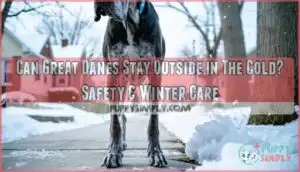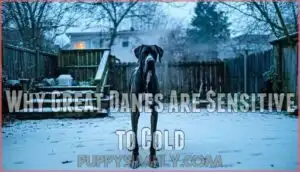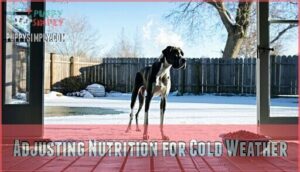This site is supported by our readers. We may earn a commission, at no cost to you, if you purchase through links.

Despite their imposing 150-pound frames, Great Danes possess dangerously poor cold tolerance due to their short coats, lean muscle structure, and minimal insulating body fat. Below 32°F, hypothermia risk climbs exponentially, with most developing distress symptoms within twenty minutes of exposure.
Understanding your dog’s physiological limitations isn’t about coddling—it’s about recognizing when their body lacks the fundamental adaptations needed for winter survival and adjusting care accordingly.
Table Of Contents
Key Takeaways
- Great Danes lack the physical adaptations for cold tolerance—their short, single-layer coats, minimal body fat, and lean muscle structure create a dangerous vulnerability below 32°F, with hypothermia risk escalating after just 10-20 minutes of exposure.
- Cold weather protection isn’t optional coddling but a medical necessity: these dogs require insulated shelters, protective gear like boots and coats, limited outdoor time (under 15 minutes in freezing temperatures), and constant monitoring for distress signals including shivering, lifted paws, and behavioral changes.
- Puppies and senior Great Danes face compounded cold weather risks due to underdeveloped thermoregulation in young dogs and age-related conditions like arthritis in older animals, requiring increased caloric intake and stricter outdoor time limitations during winter months.
- Frostbite and hypothermia progress rapidly in Great Danes—early warning signs include shivering and pale gums, while critical symptoms like stopped shivering, dilated pupils, and discolored extremities demand immediate veterinary intervention to prevent permanent tissue damage or death.
Can Great Danes Stay Outside in The Cold?
Great Danes weren’t built for harsh winters. Their short coats and lean frames offer little protection against freezing temperatures, making extended outdoor exposure risky even for these gentle giants.
Understanding their cold tolerance helps you keep them safe when the mercury drops.
Great Dane Coat and Body Structure
Great Danes wear a sleek, single-layered coat that does little to shield them from winter’s bite—think of it as a fitted dress shirt rather than a parka.
Their coat thickness doesn’t provide insulation like double-coated breeds, and their lean muscle mass combined with minimal body fat offers poor cold weather protection.
Large paw pads lose heat quickly on frozen ground, while their short fur leaves skin health vulnerable to wind and moisture, making winter care essential for maintaining proper body temperature.
Typical Cold Tolerance for Great Danes
Your Great Dane’s cold weather tolerance has clear temperature limits. They’re most comfortable between 68°F and 72°F, with discomfort starting below 44°F. Below 32°F poses serious hypothermia risk and winter hazards for these cold-sensitive Great Danes.
Cold stress builds quickly—most show distress after just 10–20 minutes in freezing conditions. Their breed sensitivity means poor cold adaptation, so limit outdoor time to 15 minutes when temperatures drop below freezing to prevent canine hypothermia.
It’s vital to recognize hypothermia warning signs to guarantee timely intervention.
Risks of Prolonged Outdoor Exposure
When your Great Dane stays outside too long in freezing weather, you’re not just risking discomfort—you’re putting their health in immediate danger. Cold stress builds rapidly, leading to canine hypothermia, frostbite, and life-threatening complications. Winter hazards multiply when cold weather dog care falls short.
Critical dangers include:
- Hypothermia risk escalates as core temperature drops, causing organ failure
- Frostbite prevention becomes urgent—ears, tail, and paws suffer tissue damage first
- Ice safety concerns arise from chemical burns and cuts on exposed paw pads
- Cold weather hazards like disorientation increase winter’s lost-dog statistics markedly
Why Great Danes Are Sensitive to Cold
Not all big dogs tolerate the cold well, and Great Danes are a perfect example. Their short coats and lean builds leave them vulnerable when temperatures drop.
Understanding what makes them sensitive helps you protect your dog better during winter months.
Short Fur and Low Body Fat
Unlike their imposing size, Great Danes lack the insulating armor that winter demands—their short, single-layer coat and minimal body fat leave them vulnerable to cold in ways that catch many owners off guard.
Despite their imposing size, Great Danes lack the insulation winter demands—their short coat and minimal body fat leave them dangerously vulnerable to cold
This lean build and minimal fur thickness offer no defense against cold stress. Your Great Dane’s body struggles to retain heat, increasing hypothermia risk during cold weather.
Without adequate winter coats or protective gear, their short coat allows rapid heat loss, making frostbite prevention for dogs with low body fat essential.
Cold-Sensitive Large Breeds
Cold stress isn’t just a Great Dane issue—it’s a concern across several large breed dog health profiles where coat thickness and lean builds create winter pet health vulnerabilities.
- Great Danes: Short coats, minimal insulation, require jackets for extended cold exposure
- Greyhounds: Need jackets and boots to protect skin and feet from cold weather and snow
- Salukis: Appreciate sweaters from first frost through spring thaw
- Mastiffs: Despite mass, short fur increases cold climate sensitivity
- Dobermans: Lean builds make them vulnerable to health risks in freezing temperatures
Breed specificity matters—these dogs need winter nutrition adjustments and protective gear to survive outdoor time safely. Understanding cold weather risks is vital for their care.
Age and Health Factors Increasing Risk
Vulnerability—whether from a puppy’s underdeveloped defenses or a senior’s declining resilience—dramatically amplifies the cold weather dangers your Great Dane faces. Puppies lack the thermoregulation capacity to maintain core temperature, making canine hypothermia a real threat during winter safety for dogs protocols.
Senior health risks multiply when age-related illness like arthritis or weakened immunity creates cold hypersensitivity.
Health condition impact extends to vulnerable populations—dogs with Primary Orthostatic Tremor or cardiac issues face exponentially higher large breed dog health complications. Your dog’s wellness depends on recognizing these factors.
How to Keep Great Danes Safe Outdoors
If your Great Dane needs to spend time outside in winter, you’ll need to take proactive steps to minimize cold stress and prevent injury. County laws in many areas require specific protections for outdoor dogs, but responsible care goes beyond minimum compliance.
Here’s what you should prioritize to keep your dog safe when outdoor time is unavoidable.
Providing Insulated Shelters and Bedding
If your Great Dane spends any time outdoors in winter, an insulated shelter isn’t optional—it’s required by law in most counties and essential for preventing hypothermia.
The shelter needs wind flaps to block drafts and non-absorbent bedding like straw or cedar shavings that won’t freeze when wet. Heated kennels or outdoor den boxes provide extra warmth, but any cold weather shelter must be elevated, dry, and sized appropriately—your dog’s body heat is what makes winter gear for Great Danes effective.
Protecting Paws From Ice and Chemicals
Your Great Dane’s paws aren’t built like winter boots—they’re vulnerable tissue that can bleed, crack, and absorb toxins with every step on frozen ground.
Apply paw balm before winter walks to create a protective barrier against ice and salt. Dog boots offer enhanced paw protection, preventing frostbite and chemical hazards from deicers.
After each outing, wipe legs and paws thoroughly—antifreeze ingestion is lethal, and road salt causes painful cracking.
Ensuring Access to Fresh, Unfrozen Water
Dehydration sneaks up fast in winter—frozen water bowls can leave your Great Dane without a drop to drink for hours, turning cold stress into a medical emergency.
Protect your dog’s winter hydration with these strategies:
- Install water bowl heaters to maintain ice-free buckets throughout freezing temperatures
- Check outdoor watering systems multiple times daily for ice formation
- Use insulated or heated bowls designed specifically for cold weather pet safety
- Bring water indoors overnight when temperatures drop below 32°F
Consistent access to unfrozen water isn’t optional—it’s essential dog health maintenance during winter care.
Signs Your Great Dane is Too Cold
Recognizing when your Great Dane is uncomfortably cold isn’t always obvious, especially since these stoic dogs often won’t immediately signal distress. Watch for physical signs like shivering, along with behavioral shifts that suggest they’re struggling with the temperature.
Here are the key warning signs that tell you it’s time to bring your dog inside.
Shivering and Physical Discomfort
Shivering is your Great Dane’s first and most obvious distress signal—a visible alarm that their body is struggling to maintain core temperature. Watch for intense trembling, hunched posture, and lifted paws—clear signs of cold stress and hypothermia risk.
Joint discomfort often worsens in freezing conditions, causing stiffness or reluctance to move. Don’t ignore these physical distress signals. Canine hypothermia develops quickly, and frostbite prevention starts with recognizing your dog’s cold weather tolerance limits.
Behavioral Changes and Distress
Beyond the physical signs, watch for subtle shifts in your Great Dane’s behavior—these often signal discomfort before the shivering even starts. Cold stress signs include:
- Whining or persistent barking indicating winter anxiety
- Seeking shelter or refusing to walk further
- Lifting alternating paws repeatedly
- Tucking tail tightly or flattening ears
- Sudden lethargy or reluctance to move
These behavioral alerts demand immediate action to prevent canine hypothermia and reduce frostbite prevention needs.
Symptoms of Hypothermia and Frostbite
When distress signals escalate into medical emergencies, recognizing hypothermia signs and frostbite risk becomes critical for canine hypothermia prevention. Hypothermia progresses from mild (90–99°F body temperature) to severe (below 82°F), with symptoms including stopped shivering, dilated pupils, slow heart rate, and collapse. Frostbite affects ears, paws, and tails—skin turns pale, gray, or black, feels brittle, and swells after warming. Both winter hazards demand immediate veterinary intervention to prevent permanent damage or death.
| Cold Stress Stage | Hypothermia Symptoms | Frostbite Signs |
|---|---|---|
| Early Warning | Shivering, pale gums, lethargy | Discolored skin (pale/gray), cold extremities |
| Critical Emergency | No shivering, dilated pupils, collapse | Black tissue, blistering, severe swelling |
| Life-Threatening | Unconsciousness, irregular breathing, cardiac arrest | Permanent tissue loss requiring amputation |
Pet emergency cold weather tips for dogs: Never delay treatment—minutes matter in frostbite prevention and reversing hypothermia damage.
Winter Care Tips for Great Danes
Keeping your Great Dane comfortable and healthy through winter takes more than just a warm coat. You’ll need to adjust their routine, diet, and living space to match the season’s demands.
Here’s what you should focus on to help your dog thrive when temperatures drop.
Limiting Outdoor Time and Walks
When temperatures drop below freezing, you need to treat outdoor time like a carefully rationed resource—most Great Danes tolerate no more than 10 to 20 minutes before cold stress sets in. Plan winter walks under 15 minutes when it’s below 32°F, and watch for shivering or reluctance to move.
Frosty conditions demand strict outdoor limits—your dog’s coat simply can’t manage prolonged exposure, no matter how enthusiastic they seem.
Adjusting Nutrition for Cold Weather
Dogs that spend significant time outdoors during winter require increased caloric intake to fuel their thermoregulation efforts. Boost your Great Dane’s protein requirements by 10 to 20 percent when outdoor exposure exceeds routine bathroom breaks.
Winter diets should emphasize nutrient-dense formulas, and some veterinarians recommend nutrient supplements for dogs in extreme climates.
Cold weather feeding isn’t optional—it’s protective nutrition that aids your dog’s body as it works overtime to maintain core temperature and winter dog health concerns.
Indoor Comfort and Mental Stimulation
Confinement indoors doesn’t mean your Great Dane’s physical and mental needs disappear—it just shifts your responsibility to meet them in creative ways. Rotate interactive toys like puzzle feeders to challenge their minds when outdoor time is limited.
Designate cozy spaces with orthopedic bedding near heat sources—not drafty windows. Indoor games such as hide-and-seek or scent work provide mental stimulation without risking cold exposure.
Calming techniques, including gentle massage, support winter dog health during prolonged indoor comfort periods.
Special Precautions for Puppies and Seniors
Vulnerability doesn’t discriminate by age—puppies and senior Great Danes face compounded risks in cold weather that demand your immediate attention. Age factors alter cold stress tolerance markedly:
- Puppies lack mature thermoregulation—limit outdoor exposure and prioritize puppy socialization indoors during winter months.
- Senior health conditions like arthritis worsen in cold weather, requiring shortened walks.
- Winter nutrition adjustments—increase caloric intake for both age groups to support temperature regulation.
- Monitor Great Danes continuously for dog cold weather safety during pet safety during winter activities.
Frequently Asked Questions (FAQs)
Can Great Danes sleep outside during winter nights?
Great Danes shouldn’t sleep outside during winter nights. Hypothermia risk increases dramatically on frozen ground. Their short coats and lean builds offer minimal insulation against nighttime cold.
Provide indoor shelter or insulated, windproof outdoor housing with proper bedding for winter safety.
What temperature is too cold for Great Danes?
Most Great Danes experience Cold Stress below 32°F, with Hypothermia Risk increasing sharply under 20°F. Your dog’s Temperature Threshold depends on wind chill, moisture, and individual tolerance.
Winter Safety means limiting outdoor time to prevent Frostbite Prevention emergencies in cold weather.
Do Great Danes need boots in the snow?
Boots aren’t strictly necessary, but they provide excellent paw protection against ice, salt, and chemical deicers that can irritate or injure your Great Dane’s feet.
If boots aren’t tolerated, apply protective wax as a winter gear alternative for snow safety.
How often should I check on outdoor dogs?
Regarding outdoor dog safety, vigilance is the name of the game. Check your Great Dane every 2–3 hours to monitor for cold stress monitoring issues, frozen water prevention needs, and hypothermia warning signs like shivering or lethargy, ensuring proper winter care routines and protecting dogs from winter elements.
Can Great Danes develop cold weather allergies?
While true cold allergies are rare, your Great Dane can develop winter skin issues that mimic allergic reactions—dryness, flaking, and irritation from low humidity and indoor heating.
Cold weather can also trigger pre-existing allergies or sensitivities, increasing hypothermia risks if immune responses weaken their tolerance.
Conclusion
Regarding whether Great Danes can stay outside in the cold, the answer isn’t just "no"—it’s "not without serious risk." Their biology leaves no room for wishful thinking. Short coats, minimal fat reserves, and rapid heat loss make prolonged winter exposure genuinely dangerous, not merely uncomfortable.
Protective gear, shortened outings, and warm indoor spaces aren’t optional luxuries—they’re survival necessities. Your Dane depends on you to recognize their vulnerability and act accordingly, because instinct alone won’t keep them safe when temperatures drop.
- https://manypets.com/us/breeds/dogs/great-dane/
- https://www.lovemargot.co/great-dane-blog?p=how-cold-is-too-cold-for-great-danes
- https://greatdanecare.com/winter-coat/
- https://news.orvis.com/dogs/which-large-dog-breeds-are-most-sensitive-to-the-cold
- https://www.zoetispetcare.com/blog/article/best-dogs-cold-weather-climates













